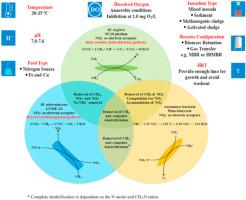Journal of Environmental Management ( IF 8.0 ) Pub Date : 2021-06-19 , DOI: 10.1016/j.jenvman.2021.113070 Rayaan Harb 1 , Dilan Laçin 1 , Irmak Subaşı 1 , Tuba H Erguder 1

|
The recently discovered process, denitrifying anaerobic methane oxidation (DAMO), links the carbon and nitrogen biogeochemical cycles via coupling the anaerobic oxidation of methane to denitrification. The DAMO process, in this respect, has the potential to mitigate the greenhouse effect through the assimilation of dissolved methane. Denitrification via methane oxidation rather than organic matter, provides a new perspective to performing this once thought to be well established process. The two main species responsible for this process are “Candidatus Methylomirabilis oxyfera (M. oxyfera), and “Candidatus Methanoperedens nitroreducens” (M. nitroreducens). M. oxyfera is responsible of reducing nitrite while M. nitroreducens reduces nitrate to nitrite. These two microorganisms, despite their different pathways, were found to exist together in nature through a syntrophic relationship. Their co-existence with anaerobic ammonium oxidation (Anammox) bacteria was also revealed in the last decade. Anammox bacteria are chemolithoautotrophs, converting ammonium and nitrite to N2 and nitrate. They are responsible for the release of more than 50% of oceanic N2, hence play an important role in the global nitrogen cycle. Factors leading to the enrichment of DAMO cultures and their cultivation with Anammox cultures are of significance for improved nitrogen removal systems with decreased greenhouse effect, and even for further full-scale applications. This study, therefore, aims to present an updated review of the DAMO process, by focusing on the factors that might have a significant role in enrichment of DAMO microorganisms and their co-existence with Anammox bacteria. Factors such as temperature, pH, inoculum and feed type, trace metals and reactor configuration are among the ones discussed in detail. Factors, which have not been investigated, are also elucidated to provide a better understanding of the process and set research goals that will aid in the development of DAMO-centered wastewater treatment alternatives.





















































 京公网安备 11010802027423号
京公网安备 11010802027423号